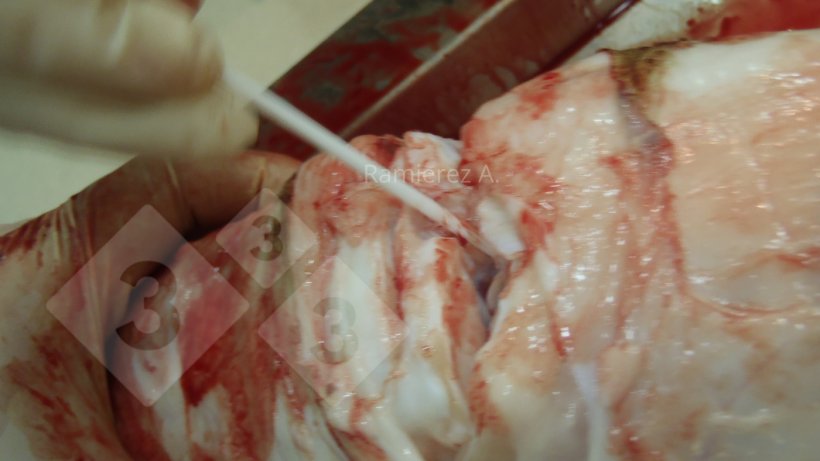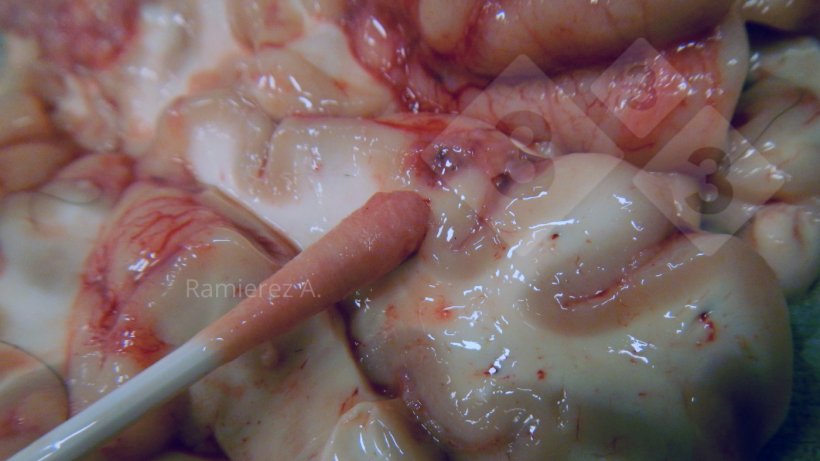Assays available
Bacterial culture

- Isolation of live organism
- Sample types: Brain, lungs, joints, spleen, pleural fluids
- Pros:
- Bacteria is easy to grow in 1 day.
- Easy to do in any lab (including in-house).
- Relative low cost.
- Can use isolate for autogenous vaccine production.
- Cons:
- Some S. suis can be isolated from clinically normal pigs (not all are virulent).
- Natural habitat: upper respiratory tract, tonsils, genitalia.
- Do not culture lung for systemic disease instead target brain, joints or spleen.
- Target lung only for cases with pneumonia.
- Pigs previously treated with antibiotics can prevent bacterial growth.
- Some S. suis can be isolated from clinically normal pigs (not all are virulent).
Antimicrobial susceptibility
- Tests in vitro ability of live organism to grow under specific concentrations of different antimicrobials.
- Sample types: Brain, lungs, joints, spleen, pleural fluids.
- Pros:
- Identification of susceptibility or resistance of specific isolate to common antimicrobials.
- Cons:
- Requires a bacterial isolate
- In vitro testing may be slightly different than in vivo results.
- Some specific antimicrobials may not be tested or require separate, special testing.
- Moderate cost.
Histopathology
- Evaluates the presence of tissue lesions (damage) which can confirm the presence of disease. Sometimes can also detect the presence of organisms directly (bacteria and parasites) or indirectly (virus) through additional special staining.
- Sample types: tissue (especially synovium for joint infections).
- Pros:
- Associate bacterial presence with tissue damage.
- No special staining needed.
- Evaluation of synovium can provide guidance on chronicity of infection.
- Cons:
- Unable to confirm S. suis as causative agent.
Serology
- Use of specific anti-serums looking for agglutination.
- Pros:
- Helps with proper vaccine selection or autogenous production (matching serotype).
- Cons:
- Requires a bacterial isolate.
- Many isolates are untypeable.
- There is multiple cross-reactivity between serotypes.
- Requires stocking of anti-serum.
- Moderate price, but usually only test 1 isolate.
Serotyping – PCR
- A polymerase chain reaction (PCR) technique that detects presence of specific sequence of nucleic acids (DNA) associated with known virulence genes.
- Pros:
- Does not requires stocking of anti-serum as with serologic serotyping.
- Helps with proper vaccine selection or autogenous production (matching serotype).
- Significantly less untypeable isolates when compared to serologic serotyping.
- Cons:
- Requires a bacterial isolate.
- Moderate price, but usually only test 1 isolate.
Result interpretation:
Bacterial culture:
- Purity:
- Pure growth: highly suggestive of disease contributor
- Mixed growth: questionable value.
- Amount:
- High: highly suggestive of disease contributor.
- Moderate: variable interpretation.
- Low: questionable value (could be contaminant).
- No growth: Animal possibly previously treated with antibiotics or not significant contributor.
Antimicrobial susceptibility:
- Susceptible: possible good choice for treatment if antimicrobial can reach target tissue.
- Resistant: select different antimicrobial.
- MIC (Minimum inhibitory concentrations): if MICs are done, ensure antimicrobial selected achieves the listed MIC value in the target organ.
Histopathology:
- Positive: Strong association if matches clinical signs.
- Negative: No lesions.
Serotyping (Serologic and PCR):
- Serotyping is very valuable in helping select isolates for autogenous vaccination.
Scenario
Pigs with swollen joints (any age):
- From dead or euthanized pigs, collect joint swabs (or synovial fluid) as well as synovium tissue from 2 or more untreated pigs with acute, swollen joints. Submit swab/synovial fluid for bacterial culture, antimicrobial susceptibility, and serotyping via PCR. Submit synovial tissue in formalin for histopathologic evaluation.



- Anesthetize 1-3 untreated pigs with acute, swollen joints and perform a sterile joint tap. Submit joint fluid chilled for bacterial culture, antimicrobial susceptibility, and serotyping.
Pig with CNS (central nervous system) signs:
- Euthanize pig and obtain a sterile brain swab from ventral surface of brain and submit sample chilled for bacterial culture, antimicrobial susceptibility, and serotyping via PCR. Also submit half of brain (including meninges if possible) in formalin for histopathologic evaluation.




